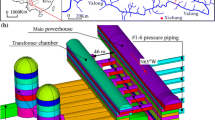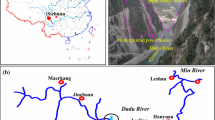Abstract
The surrounding rock mass stability is the key to the construction of underground powerhouses in hydropower stations. However, high in situ stress and complex geological conditions pose substantial challenges to the construction safety and stability of large underground powerhouses, which can lead to deformation and failure of the surrounding rock mass. This paper considers tailrace surge chamber #8 of the Baihetan Hydropower Station as a case study, which is one of the largest cylindrical tailrace surge chambers in the world. In this case, the shotcrete on the vertical wall cracked and fell off after tailrace surge chamber #8 was excavated and systematically supported. Simultaneously, large deformation of the surrounding rock mass occurred, and some anchor cables failed at the cracking area. By site monitoring and field surveys, the deformation and failure characteristics are described. Based on numerical simulations, the stress evolution induced by excavation is studied, and the mechanism of deformation and failure is analyzed. The results indicate that the high in situ stress, interlayer shear zone, and brittle surrounding rock mass were the main reasons. Under high in situ stress, compressive stress was concentrated near the vertical wall after the excavation. In the presence of interlayer shear zone C4, the stress concentration was enhanced and caused the surrounding rock mass to be subjected to high tangential stress, which led to the large deformation and failure.













Similar content being viewed by others
References
Bhatkar T, Mandal A, Kumar C, Usmani A (2017) Risk management by geotechnical monitoring for safe excavation of a large rock cavern: a case study. Bull Eng Geol Environ 76(3):1209–1216
Duan S-Q, Jiang Q, Liu G-F, Xiong J-C, Gao Po, Xu D-P, Li M-Y (2021) An Insight into the Excavation-Induced Stress Paths on Mechanical Response of Weak Interlayer Zone in Underground Cavern Under High Geostress. Rock Mech Rock Eng 54(3):1331–1354. https://doi.org/10.1007/s00603-020-02312-y
Fan QX, Feng XT, Weng WL, Fan YL, Jiang Q (2017) Unloading performances and stabilizing practices for columnar jointed basalt: a case study of Baihetan hydropower station. J Rock Mech Geotech Eng 9(6):1041–1053
Feng XT, Zhou YY, Jiang Q (2019) Rock mechanics contributions to recent hydroelectric developments in China. J Rock Mech Geotech Eng 11(003):511–526
Goktan RM, Yilmaz NG (2005) A new methodology for the analysis of the relationship between rock brittleness index and drag pick cutting efficiency. J S Afr Inst Min Metall 105(10):727–732
Guo HS, Feng XT, Li SJ, Yang CX, Yao ZB (2017) Evaluation of the integrity of deep rock masses using results of digital borehole televiewers. Rock Mech Rock Eng 50(6):1–12
Hatzor YH, Feng XT, Li SJ, Yagoda-Biran G, Jiang Q, Hu LX (2015) Tunnel reinforcement in columnar jointed basalts: the role of rock mass anisotropy. Tunn Undergr Space Technol 46:1–11
Hydro China Huadong Engineering Corporation (2019) Volume I engineering geology, volume II design report, special acceptance of the underground powerhouse of the Baihetan Hydropower Station on the Jinsha River during the excavation and support phase. (in Chinese)
Kong DQ, Qiao CS, Xue GC (2020) Stability evaluation of flat large-span cavern in jointed rock mass. Arab J Geosci 13(11):1–14
Kumar V, Jha PC, Singh NP, Cherukuri S (2021) Dynamic stability evaluation of underground powerhouse cavern using microseismic monitoring. Geotech Geol Eng 39:1795–1815
Li SJ, Feng XT, Li ZH, Zhang CQ, Chen BR (2012a) Evolution of fractures in the excavation damaged zone of a deeply buried tunnel during TBM construction. Int J Rock Mech Min Sci 55:125–138
Li SJ, Feng XT, Li ZH, Chen BR, Zhang CQ, Zhou H (2012b) In situ monitoring of rockburst nucleation and evolution in the deeply buried tunnels of Jinping II hydropower station. Eng Geol 137–138:85–96
Li B, Ding QF, Xu NW, Lei YF, Xu Y, Zhu ZP, Liu JF (2020a) Mechanical response and stability analysis of rock mass in high geostress underground powerhouse caverns subjected to excavation. J Cent South Univ 27(10):2971–2984
Li ZQ, Xue YG, Li SC, Qiu DH, Zhang LW, Zhao Y, Zhou BH (2020b) Rock burst risk assessment in deep-buried underground caverns: a novel analysis method. Arab J Geosci 13:388
Li F, Zhang QY, Xiang W, Yu GY (2022) Failure mechanism and numerical simulation of splitting failure for deep high sidewall cavern under high stress. Geotechn Geol Eng 40:175–193
Liang ZZ, Xue RX, Xu NW, Dong LL, Zhang YH (2020) Analysis on microseismic characteristics and stability of the access tunnel in the main powerhouse, Shuangjiangkou hydropower station, under high in situ stress. Bull Eng Geol Environ 79(6):3231–3244
Ning ZX, Xue YG, Su MX, Qiu DH, Zhang K, Li ZQ, Liu YM (2021) Deformation characteristics observed during multi-step excavation of underground oil storage caverns based on field monitoring and numerical simulation. Environ Earth Sci 80:222
Qian QH, Zhou XP (2018) Failure behaviors and rock deformation during excavation of underground cavern group for Jinping I Hydropower Station. Rock Mech Rock Eng 51:2639–2651
Rezaei M, Rajabi M (2021) Assessment of plastic zones surrounding the power station cavern using numerical, fuzzy and statistical models. Eng Comput 37:1499–1518
Szwedzicki T (2003) Rock mass behaviour prior to failure. Int J Rock Mech Min Sci 40:573–584
Vazaios I, Vlachopoulos N, Diederichs MS (2019) Assessing fracturing mechanisms and evolution of excavation damaged zone of tunnels in interlocked rock masses at high stresses using a finite-discrete element approach. J Rock Mech Geotech Eng 11(4):701–722
Wang LY, Chen WZ, Tan XY, Tan XJ, Yang JP, Yang DS, Zhang X (2019) Numerical investigation on the stability of deforming fractured rocks using discrete fracture networks: a case study of underground excavation. Bull Eng Geol Environ 79:133–151
Wu SY, Shen MB, Wang J (2010) Jinping hydropower project: main technical issues on engineering geology and rock mechanics. Bull Eng Geol Environ 69(3):325–332
Wu AQ, Yang QG, Ding XL, Zhou HM, Lu B (2011) Key rock mechanical problems of underground powerhouse in Shuibuya hydropower station. J Rock Mech Geotech Eng 3(1):64–72
Xiao YX, Zheng JX, Zhang JH (2018) Study on overall stability of underground powerhouse of a super-large cylinder-type tailrace surge chamber. In: Proceedings of the 6th Academic Conference of Geology Resource Management and Sustainable Development, (eds) by Henry Zhang and Changbo Cheng. Beijing, 428–436
Xu NW, Dai F, Li B, Zhu YG, Zhao T, Yang DS (2017) Comprehensive evaluation of excavation-damaged zones in the deep underground caverns of the Houziyan hydropower station, Southwest China. Bull Eng Geol Environ 76:275–293
Xu J, Jiang JD, Liu QS, Gao YF (2018) Stability analysis and failure forecasting of deep-buried underground caverns based on microseismic monitoring. Arab J Sci Eng 43(4):1709–1719
Xu DP, Huang X, Jiang Q, Li SJ, Zheng H, Qiu SL, Xu HS, Li YH, Li ZG, Ma XD (2021) Estimation of the three-dimensional in situ stress field around a large deep underground cavern group near a valley. J Rock Mech Geotech Eng 13:529–544
Zhang CQ, Zhou H, Feng XT (2011) An index for estimating the stability of brittle surrounding rock mass: FAI and its engineering application. Rock Mech Rock Eng 44(4):401–414
Zhang CS, Liu N, Chu WJ (2016a) Key technologies and risk management of deep tunnel construction at Jinping II hydropower station. J Rock Mech Geotech Eng 8(4):499–512
Zhang L, Liu YR, Yang Q (2016b) Study on time-dependent behavior and stability assessment of deep-buried tunnels based on internal state variable theory. Tunn Undergr Space Technol 51:164–174
Zhang Y, Feng X-T, Yang C, Han Q, Wang Z, Kong R (2021) Evaluation Method of Rock Brittleness under True Triaxial Stress States Based on Pre-peak Deformation Characteristic and Post-peak Energy Evolution. Rock Mech Rock Eng 54(3):1277–1291. https://doi.org/10.1007/s00603-020-02330-w
Zhou YY, Xu DP, Liu K, Chen DF (2021) Understanding the failure mechanism of a large underground cavern in steeply dipping layered rock mass using an enhanced ubiquitous-joint model. Bull Eng Geol Environ 80(3):4621–4638
Acknowledgements
Critical comments by the anonymous reviewers greatly improved the initial manuscript.
Funding
The authors gratefully acknowledge the support of the Graduate Student’s Research Innovation Foundation of Sichuan University (2018YJSY076) and the Sichuan Youth Science and Technology Innovation Research Team Project (2020JDTD0006).
Author information
Authors and Affiliations
Corresponding author
Ethics declarations
Conflict of interest
The authors declare no competing interests.
Additional information
Responsible Editor: Zeynal Abiddin Erguler
Rights and permissions
About this article
Cite this article
Wang, M., Shi, A., Li, H. et al. Deformation and failure mechanism analyses for the surrounding rock mass in a large cylindrical tailrace surge chamber. Arab J Geosci 15, 400 (2022). https://doi.org/10.1007/s12517-022-09716-w
Received:
Accepted:
Published:
DOI: https://doi.org/10.1007/s12517-022-09716-w




